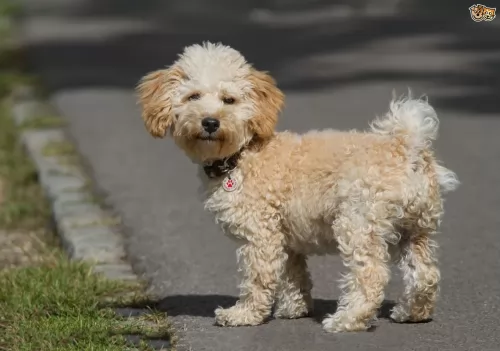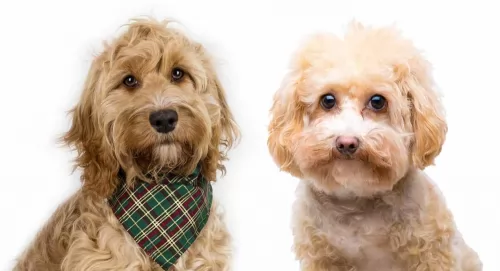 Petzlover
Petzlover Cavapoo is originated from United States but Havanese is originated from Cuba. Cavapoo may grow 6 cm / 3 inches higher than Havanese. Cavapoo may weigh 6 kg / 14 pounds more than Havanese. Both Cavapoo and Havanese has almost same life span. Cavapoo may have less litter size than Havanese. Cavapoo requires Moderate Maintenance. But Havanese requires High Maintenance
Cavapoo is originated from United States but Havanese is originated from Cuba. Cavapoo may grow 6 cm / 3 inches higher than Havanese. Cavapoo may weigh 6 kg / 14 pounds more than Havanese. Both Cavapoo and Havanese has almost same life span. Cavapoo may have less litter size than Havanese. Cavapoo requires Moderate Maintenance. But Havanese requires High Maintenance
 The Cavapoo, known also as the Cavoodle, is a small dog – a mix of a miniature Poodle and a Cavalier King Charles Spaniel.
The Cavapoo, known also as the Cavoodle, is a small dog – a mix of a miniature Poodle and a Cavalier King Charles Spaniel.
He hasn’t got a long history, but each of the dogs he comes from – the Cavalier King Charles Spaniel and the Poodle – have longer histories. The Cavapoo started being bred in the United States, but he has a short history in America. In Australia, they were first bred in the 1990s.
Today, as a hybrid, the Cavapoo isn’t recognized by the American Kennel Club but he is recognized by the American Canine Hybrid Club as well as the Designer Dogs KennelClub.
 The only breed of dog that is native to Cuba is the Havanese. These little dogs are great companion animals. Sociable and happy, they are very popular in the United States with urbanites. These happy little pups are a Bichon type of dog which was developed from the “Little White Dog of Havana” or the Blanquito de la Habana which is now extinct.
The only breed of dog that is native to Cuba is the Havanese. These little dogs are great companion animals. Sociable and happy, they are very popular in the United States with urbanites. These happy little pups are a Bichon type of dog which was developed from the “Little White Dog of Havana” or the Blanquito de la Habana which is now extinct.
The Blanquito de la Habana was itself developed from another extinct breed the Bichon Tenerife. Then the Blanquito was bred with the other Bichons and poodles in developing the Havanese. It is believed that some of the first people to settle in Cuba were from Tenerife, an island close to Cuba. In the early part of the sixteenth century, little white dogs were brought to Cuba with these settlers. This dog of Tenerife is believed to be the ancestor of all Bichon breeds.
At that time trade with Cuba was highly restricted by the Spanish and so these dogs developed without any crossing from other breeds from outside the country. They grew to be able to stand hot temperatures and they grew a very unique coat – almost like silk. Their coat is soft and light, while insulating them from the tropical environment.
At this time Cuba was the place to be for Europeans aristocrats on vacation. Unlike the British colonies, Cuba had theatres, operas and palacious. When going back to Europe, many took this little white dog with them to France, Spain and England. The Dog of Havannah was a favorite on European soil as well. Many of these dogs taken to Europe were fawn or parti instead of white. Meanwhile back in Cuba, the bourgeoisie were replacing the aristocracy who themselves would soon be replaced by the Revolution.
During the days of the bourgeoisie, the Havanese became very popular household pets. The breed has been a family pet for the last 150 years. At the same time the breed was very trendy in Europe with Charles Dickens and Queen Victoria owning several. They were by now familiar participants in Europe’s dog shows. Finally, with the Revolution, the bourgeoisie left the country in droves with their little white dogs. A genetic pool was then formed in the US. Gene pool from 11 dogs. All the Havanese in the world are descended from those 11 dogs with the exception of the dogs isolated in Cuba and the US. Today the Havanese is one of the most popular and fastest growing breeds in the world.
 The Cavapoo can be found in different colors and he can be blonde, white, brown, white or black or even tri-colored. Sometimes the coat can be a little bit curly but it can also sometimes be a long, silky coat from the Cavalier.
The Cavapoo can be found in different colors and he can be blonde, white, brown, white or black or even tri-colored. Sometimes the coat can be a little bit curly but it can also sometimes be a long, silky coat from the Cavalier.
Dogs crossed with poodles, such as the Cavapoo, are known to be hypoallergenic, but there is really no 100% guarantee that he will be hypoallergenic.He has a round face with large, brown eyes and long ears. He can adapt easily to life in the city or in the countryside.
The Cavapoo is a small dog breed that has been bred to be an amicable pet. He gets along well with adults and children as well as other pets in the home. He stands about 28–33cm in height and can weigh anything from 5 to 12 kg.
He is an intelligent little dog, alert and inquisitive. Even a small, non-aggressive dog such as the Cavapoo can do well with training and socialization as he is quick to learn. With this socialization he becomes an obedient, affectionate, well behaved 4-legged family member.
Loyal and friendly, the Cavapoo thrives on human companionship and he just loves to be involved in everything the family is getting up to. He isn’t a dog that can be left on his own too long as this is when he develops irritating behavior patterns such as ongoing yapping and barking.
 The Havanese is a sturdy little dog, a member of the toy group. They weigh no more than 16 pounds (7.3kg) and his body is longer than it is tall. The breed has a unique topline that is not level, but it is straight. His front legs are longer than his hind legs producing the lively gait everyone is used to seeing with a Havanese. With a full muzzle that tapers to the nose, the Havanese does not seem to be short. The skull’s length is the same as the muzzle’s. The head of the Havanese is round in the back and flat in the front.
The Havanese is a sturdy little dog, a member of the toy group. They weigh no more than 16 pounds (7.3kg) and his body is longer than it is tall. The breed has a unique topline that is not level, but it is straight. His front legs are longer than his hind legs producing the lively gait everyone is used to seeing with a Havanese. With a full muzzle that tapers to the nose, the Havanese does not seem to be short. The skull’s length is the same as the muzzle’s. The head of the Havanese is round in the back and flat in the front.
They have a deep chest, almond shaped eyes that are dark brown and their ears are about halfway down the nose. The long ears hang down the side od the face. They have a long plumed tail that is held high and upward. The standard for the breed and now the laws of the United Kingdom state that there can be no docking of the tail.
 Pet lovers who welcome a Cavapoo into their home aren’t going to be disappointed if they stick to their side of the bargain and provide their pet with lots of love and care.
Pet lovers who welcome a Cavapoo into their home aren’t going to be disappointed if they stick to their side of the bargain and provide their pet with lots of love and care.
The Cavapoo suits any kind of family because he is playful, loving, loyal and comes with a balanced and amicable personality.
Keep him happy with good food, clean water and lots of your attention and he’ll respond by being the perfect companion for you.
 Havanese are highly intelligent and eager to please, and they are easily trained so long as you use only positive methods. This can be a sensitive breed, so care must be taken to not scold them harshly. Socialization from an early age is very important. Expose them calmly to a wide variety of new places and new people, always ensuring that the experiences are positive and not intimidating. Gentle, patient training will result in a wonderful companion dog. They are affectionate with people and get along with other nonaggressive pets.
Havanese are highly intelligent and eager to please, and they are easily trained so long as you use only positive methods. This can be a sensitive breed, so care must be taken to not scold them harshly. Socialization from an early age is very important. Expose them calmly to a wide variety of new places and new people, always ensuring that the experiences are positive and not intimidating. Gentle, patient training will result in a wonderful companion dog. They are affectionate with people and get along with other nonaggressive pets.
The Havanese is the consummate lap dog. Over time they have become the lovable family companion.
The breed is pretty adaptable being able to live as a companion animal in almost any setting. Just don’t expect your Havanese to go hiking or romp with you on 40 acres in the country.
They are intelligent, love to learn but can be a little stubborn. Train them early as they like their habits and its much harder to train an older Havanese.
 The Cavapoo is considered a healthy little dog who is active and energetic. Because he is a hybrid, he could develop illnesses associated with either of the dog types he comes from. However this is highly unlikely and you can expect up to 15 years from your Cavapoo if you feed him correctly and shower him with lots of love and attention.
The Cavapoo is considered a healthy little dog who is active and energetic. Because he is a hybrid, he could develop illnesses associated with either of the dog types he comes from. However this is highly unlikely and you can expect up to 15 years from your Cavapoo if you feed him correctly and shower him with lots of love and attention.
Dogs with long, floppy ears tend to be more prone to ear infections. You’ll have cause for concern when you see your dog scratching his ears or shaking his head. There are one or two reasons why your Cavapoo may get an ear infection, and food allergies could be one.
A food allergy can bring about inflammation that can lead to infections. Moisture and excessive wax can also cause an ear infection. You can use cotton wool and some ear cleaner to remove dirt and moisture, but if in any doubt, speak to your vet or get your pet to the vet for advice.
Small dogs are more prone to dental disease, and your Cavapoo’s teeth should be brushed 2 or 3 times a week with a vet-approved special dog toothpaste and brush. This can prevent dental decay which can bring about a whole lot of problems with his teeth but also with other parts of the body.
 A very healthy breed, the Havanese doesn’t have a lot of health issues, but they are not immune to the problems of small breed dogs. The issues they do have are:
A very healthy breed, the Havanese doesn’t have a lot of health issues, but they are not immune to the problems of small breed dogs. The issues they do have are:
 The Cavapoo doesn’t shed much so he won’t need that much grooming, although there are people who take him to a doggy parlor to see that the hair is trimmed into shape. If not, then a good brushing twice a week will ensure the hair doesn’t matt and that it remains free of lots of dead hair.
The Cavapoo doesn’t shed much so he won’t need that much grooming, although there are people who take him to a doggy parlor to see that the hair is trimmed into shape. If not, then a good brushing twice a week will ensure the hair doesn’t matt and that it remains free of lots of dead hair.
With any dog, and not just the Cavapoo, you want a food that boosts energy and promotes longevity. The Cavapoo breed is energetic and lively, and it is this stamina of his that will require you feeding him top quality food that is rich in nutrients.
Small dogs have a higher calorie need than large dogs because their metabolisms are much faster. Protein and fat are important nutrients for small-breed dogs and these nutrients need to come from high-quality sources. Speak to your vet about the best food for your Cavapoo and always ensure that he has a bowl of clean water available.
 Feed 3 to 4 times per day a high quality dry puppy food for toy or small dogs. Feed ¼ to ½ cup each time.
Feed 3 to 4 times per day a high quality dry puppy food for toy or small dogs. Feed ¼ to ½ cup each time.
Remember these are small dogs and don’t overfeed. Feed a high quality dry food for small or toy dogs. Feed twice a day at about ½ cup each time.
The breed is generally very healthy.
This breed is not an overly active dog, but he does need some exercise. A nice walk once a day or a backyard to play in. They play inside as well as out. Don’t over exercise the Havanese. They do well in obedience and confirmation more so than agility or fly ball